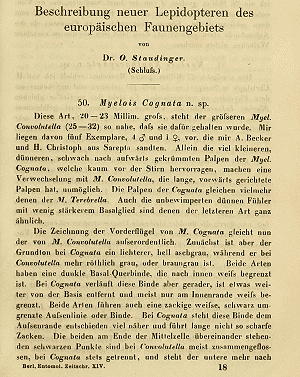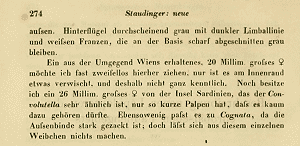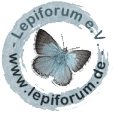

 +5Kontinente:EUAS
+5Kontinente:EUAS2. Diagnose
2.1. Erstbeschreibung
3. Weitere Informationen
3.1. Etymologie (Namenserklärung)
„cognatus verwandt.“
3.2. Andere Kombinationen
- Myelois cognata Staudinger, 1871 [Originalkombination]
3.3. Taxonomie
Leraut (2014) bezweifelt das Artrecht und sieht in diesen Tieren besonders große Vertreter von Apomyelois bistriatella - eine formale Synonymisierung nimmt er aber nicht vor. Trofimova et al. (2022) nehmen eine Neubeschreibung der Art vor und bestätigen dabei die Artberechtigung.
3.4. Faunistik
Die Art wurde aus dem Wolga-Ural-Gebiet ("Sarepta") in Russland beschrieben, dort aber seit der Erstbeschreibung nicht mehr bestätigt. Trofimova et al. (2022) melden den Neufund von insgesamt 17 Faltern von 3 Fundorten im Süd-Ural. Alte Angaben gibt es nach ihnen aus dem Iran und - unbestätigt und damit sehr fraglich - von Zypern. Sie fassen zusammen: "Distribution - European Russia (Volgograd and Orenburg regions), Cyprus (?), Iran."
Yepishin et al. (2025: 10) melden aus der Ukraine: "Luhansk reg., Siverskodonetsk distr., Sievierodonetsk [Siverskodonetsk], residential quarters, at light, 10.VIII.2011, 1♂ S. Demyanenko leg.; gen. prep. 627.22s V. Yepishin. Luhansk reg., Siverskodonetsk distr., S vic. of Sievierodonetsk [Siverskodonetsk], dacha near the lake Kleshnia, at light, 28.IV.2013, 6.VIII. and 20.VIII.2021, 3♀ S. Demyanenko leg.; gen. prep. 625.22s, 628.22s, 634.22s V. Yepishin (all VYe). Distribution in Ukraine: First record from Ukraine. Remarks. The report of Apomyelois bistriatella from Luhansk region in Bidzilya et al. (2013: 27) belongs to A. cognata due to a misidentification, which was examined by dissection of genitalia (Figs 20a–d). For the diagnostic differences, see Remarks section of previous species." Bei jener Art ist zu lesen: "Distribution in Ukraine: Kyiv reg.: iNaturalist 2025 (122913615). First record from Zhytomyr region and first confirmed record from Luhansk region (see Remarks section of Apomyelois cognata). Remarks. The adults of A. bistriatella (Figs 11–12) are quite similar to A. cognata (Figs 13–15), but differ by darker wing colouration and often smaller sizes. In female genitalia, the corpus bursae is elongated, spindle-shaped, the apex is more pointed (Figs 16–17), in A. cognata, the shape of corpus bursae is pyriform, and the apex is more rounded (Figs 18–19). The male genitalia of A. bistriatella are almost indistinguishable from those of A. cognata, the most important feature is the almost flat, with a slight depression, top of the transtilla, which in A. cognata is noticeably bifurcated (Fig. 20a)."
(Autor: Erwin Rennwald)
3.5. Typenmaterial
Trofimova et al. (2022) stellen zusammen: "Type material. Lectotype, ♂, here designated, labelled: “Origin.”; “Sarepta”; “Myelois cognata Stgr”; “U. Roesler ♂ GU 3310”; “LectoHolotypus Myelois cognata Stgr. U. Roesler”; “Lectotypus Myelois cognata Staudinger, 1871, des. T.A. Trofimova, J. Šumpich, Yu.I. Budashkin, 2021” (MfN). Paralectotypes, 1 ♂, 1 ♀, here designated, labelled: “Origin”; “Sarepta”; “Myelois cognata Stgr.”; “U. Roesler ♀ GU 3309”; “Allolectotypus Myelois cognata Stgr. U. Roesler”; “Paralectotypus Myelois cognata Staudinger, 1871, des. T.A. Trofimova, J. Šumpich, Yu.I. Budashkin, 2021” (MfN) and “Origin”; “Sarepta”, “Myelois cognata Stgr.”; “Paralectotypus Myelois cognata Staudinger, 1871, des. T.A. Trofimova, J. Šumpich, Yu.I. Budashkin, 2021” (MfN)."
3.6. Literatur
- Leraut, P. (2014): Moths of Europe. Volume 4. Pyralids 2. - 441 S.; Verrières-le-Buisson (N.A.P Editions).
- Erstbeschreibung: Staudinger, O. (1871) ["1870"]: Beschreibung neuer Lepidopteren des europäischen Faunengebiets (Schluß). — Berliner Entomologische Zeitschrift 14: 273-330.
- Trofimova, T.A., Šumpich, J. & Y.I. Budashkin (2022): Redescription of Apomyelois cognata (Staudinger, 1871) (Lepidoptera, Pyralidae, Phycitinae) with first record from the South Urals. — Nota Lepidopterologica, 45: 1–7. DOI 10.3897/nl.45.73925. [zum open-access-Artikel auf pensoft.net]









